Eastern Bluebird
Sialia sialis
Bluebirds drop straight down on their prey from their perch, much like leopards.
Advertisement
Eastern Bluebird Scientific Classification
- Kingdom
- Animalia
- Phylum
- Chordata
- Class
- Aves
- Order
- Passeriformes
- Family
- Turdidae
- Genus
- Sialia
- Scientific Name
- Sialia sialis
Read our Complete Guide to Classification of Animals.
Eastern Bluebird Conservation Status
Eastern Bluebird Facts
- Prey
- Insects, snails, spiders, beetles, earthworms, grasshoppers, katydids, crickets and other small invertebrates.
- Fun Fact
- Bluebirds drop straight down on their prey from their perch, much like leopards.
- Estimated Population Size
- 20 million
- Biggest Threat
- Habitat destruction, invasive species, pet cats
- Most Distinctive Feature
- The bright blue color of the male’s feathers
- Other Name(s)
- Blue robin
- Wingspan
- 9.8 to 12.6 inches across
- Incubation Period
- About two weeks.
- Litter Size
- Three to seven
- Habitat
- Habitat includes farmland, open country, parks, orchards, backyards, hedgerows
- Predators
- Rodents, black bears, raccoons, snakes, cats, birds of prey and fire ants.
- Diet
- Omnivore
- Type
- Bird
- Common Name
- Bluebird
- Number Of Species
- 8
- Location
- North and Central America east of the Rocky Mountains
- Average Clutch Size
- 7
- Nesting Location
- Abandoned woodpecker hole or other tree cavities a few feet from the ground.
- Age of Molting
- 15 days
- Migratory
- 1
View all of the Eastern Bluebird images!
“The Eastern Bluebird is the only bluebird found east of the Rockies.”
These beautiful and beloved little birds are considered harbingers of spring and in some places, their song can be heard even when snow is still on the ground. Unlike so many other animals, their status is of least concern, and their numbers are actually increasing. This is largely due to the fact that bluebirds have no trouble living around human beings and won’t hesitate to build a nest in a house provided for them. They return the favor by eating insect pests.
Amazing facts
Some facts about the Eastern bluebird are:
- They usually raise two broods a year. The chicks from the first brood sometimes help raise the chicks from the second.
- The female is a little larger than the male.
- Another interesting bluebird fact is that bluebirds aren’t really blue. Their blue coloration is a trick of the light. Check out a list of types of birds that appear blue.
- Bluebirds who live in the northern and western parts of the range lay more eggs than those that live in the southern and eastern parts of the range.
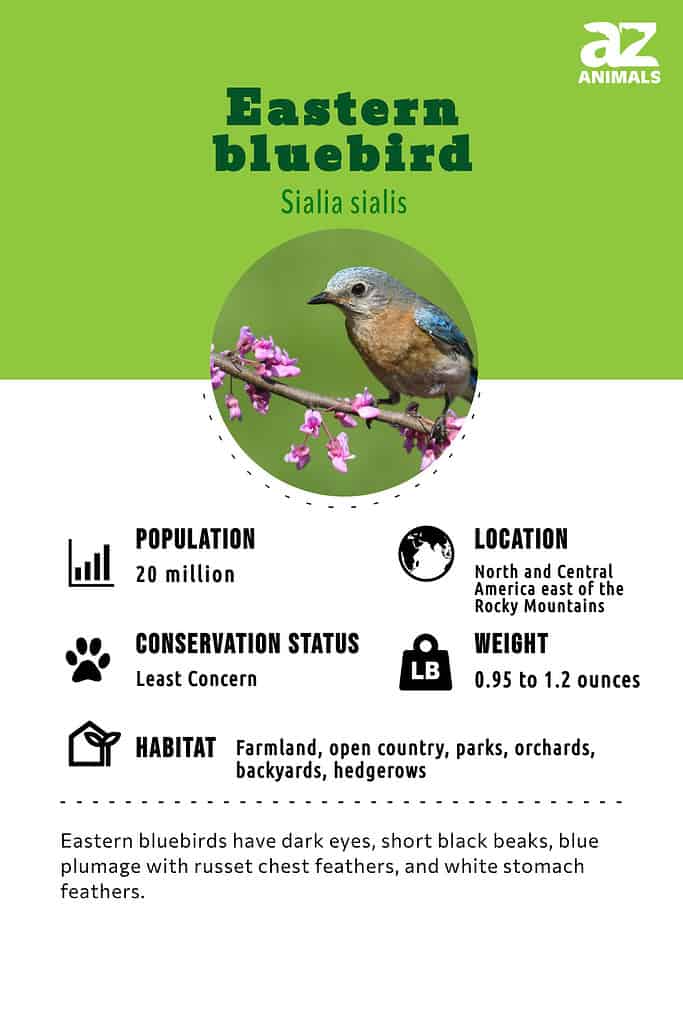
Where To Find Eastern Bluebirds

Eastern bluebirds can be seen as far south as Florida and as far north as Massachusetts
©Steve Byland/Shutterstock.com
The Eastern bluebird is a favorite of birdwatchers because it is conspicuous and generally easy to find. A birdwatcher has the best chance of finding an Eastern bluebird in the places where they live year-round. This would be in states found east of the Rockies below the 40th parallel, as far south as West Palm Beach Florida, and as far north as the Cape Cod Peninsula in Massachusetts. The bird can be seen perching on a fence, or a telephone wire or may show up as a flash of blue in the grass as it dives after a worm. If it’s the breeding season, the birdwatcher might catch a pair building a nest in a bluebird house, or in a cavity of a dead tree. The bird may even swoop by, singing. The birdwatcher may even see an enormous flock of bluebirds, heading somewhere.
People who live north of the 40th parallel can see the bluebird during the spring when it comes to breed. The birds can be found, again east of the Rockies and as far north as Yellowknife in the Northwest Territories and as far east as Nova Scotia.
Nests
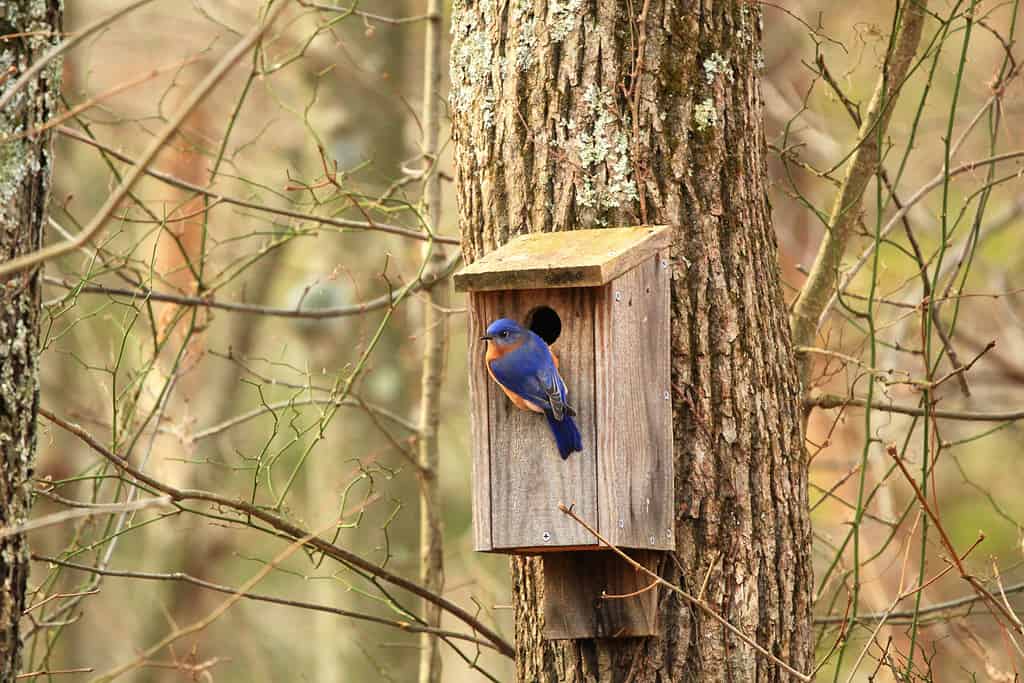
Eastern bluebirds take over a week to build a nest with the female handling the bulk of the work
©iStock.com/db_beyer
The bluebird’s nest is cup-shaped, rather loose, and made of twigs, hair, feathers, or grass. Some ornithologists recommend people spread lint from the lint filter of their dryers outside so the bird can use it to build its nest.
The female does most of the work of building the nest, and the endeavor usually takes about 10 days. She will make the nest in a cavity made by a woodpecker or a house that’s been provided by a human. Bluebirds prefer their nest boxes to be between 2 and 50 feet off the ground.
Scientific name
The Eastern bluebird’s scientific name is Sialia sialis, which is Greek for “a type of bird.” There are seven subspecies:
- Sialia sialis sialis
- Sialia sialis bermudensis
- Sialia sialis nidificans
- Sialia sialis fulva
- Sialia sialis guatemalae
- Sialia sialis meridionalis
- Sialia sialis caribaea
Evolution
Eastern bluebirds belong to the genus (group of closely related animals with common characteristics), Sialia. As a result, their closest cousins which are also part of the same genus include Mountain and Western bluebirds. A rung further up the biological ladder reveals these birds to be members of the Turdidae, or thrush family. A rather large group, it consists of 17 genera and 175 species, including the Turdus, true thrushes, Zoothera, Asian thrushes, and Stizorhina, rufous thrushes.
Another rung further up, and we find that all these thrushes are Passeriformes, the largest avian order which contains about 6,500 species – over half of all extant species. Definitive evidence of these birds exists dating back to the Oligocene (23 – 33.9 million years ago). Fossils belonging to this era have been found in Europe, in Germany and Poland, to be precise.
Appearance
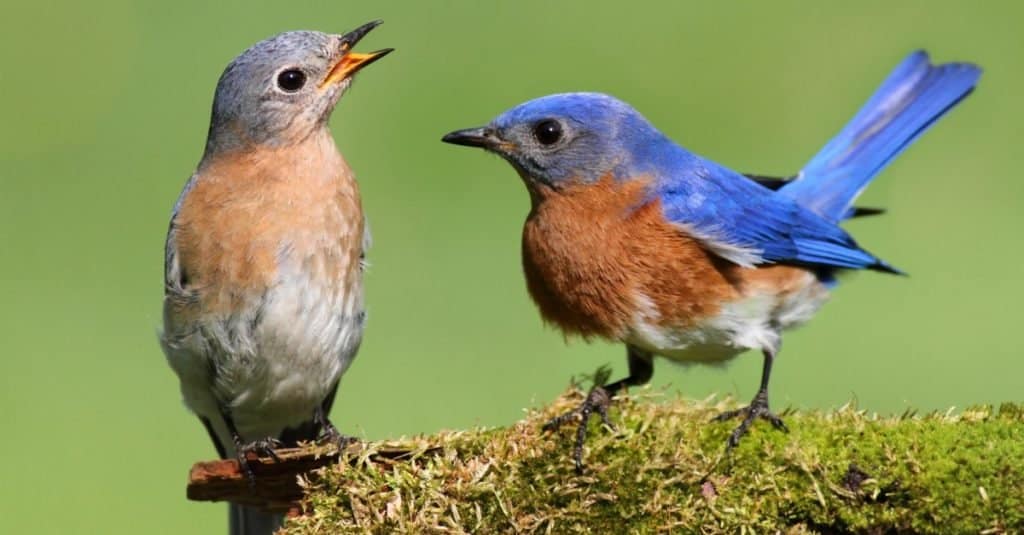
Eastern Bluebird females are slightly larger than males with duller plumage
©Steve Byland/Shutterstock.com
The Eastern bluebird is about 7 inches long on average, with a 9.8 to 12.6 wingspan. The male has a back of pure, bright blue, a rusty breast, and a white belly. They have small beaks and short legs and weigh about an ounce. The female is a little larger, but her plumage is duller, and juveniles are brownish-gray with a bit of blue on the wings and tail. They have spots on their breast that disappear as they mature.
Eastern bluebirds tend to have a hunched look when they perch. The coloration of the juvenile and the female is probably protective and keeps them hidden from predators. Any blue in the plumage comes about when the light strikes proteins arranged a certain way in the feathers, for no bird can create blue pigment the way it can create red or yellow pigment.
Behavior
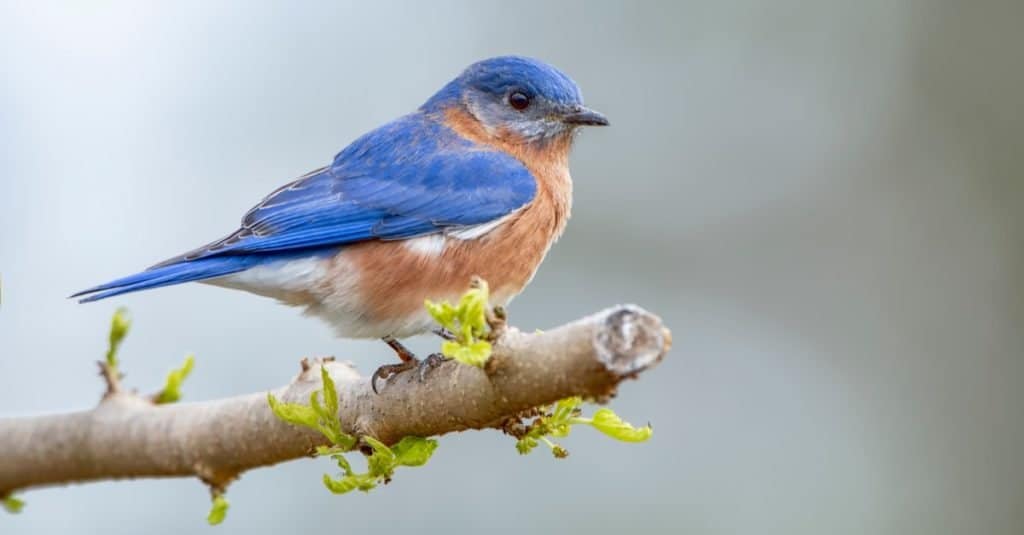
Although Eastern Bluebirds are social birds, males turn territorial during breeding season
©Bonnie Taylor Barry/Shutterstock.com
Eastern bluebirds are gregarious save for the breeding season when a male claims a one or two-acre territory and defends it. He’ll also defend a feeding territory during the winter. Other than that, bluebirds can form huge flocks. The birds are monogamous during the breeding season unless they’re not. It has been shown that some birds have chicks by more than one mate at a time.
Migration Pattern and Timing
Migration for eastern bluebirds in the southern part of their range tends not to happen unless food is very scarce. Birds in the northern part of the range fly south during the winter, and there is a specific area in western Texas and northeast Mexico where some populations of Eastern bluebirds spend their winters.
Diet
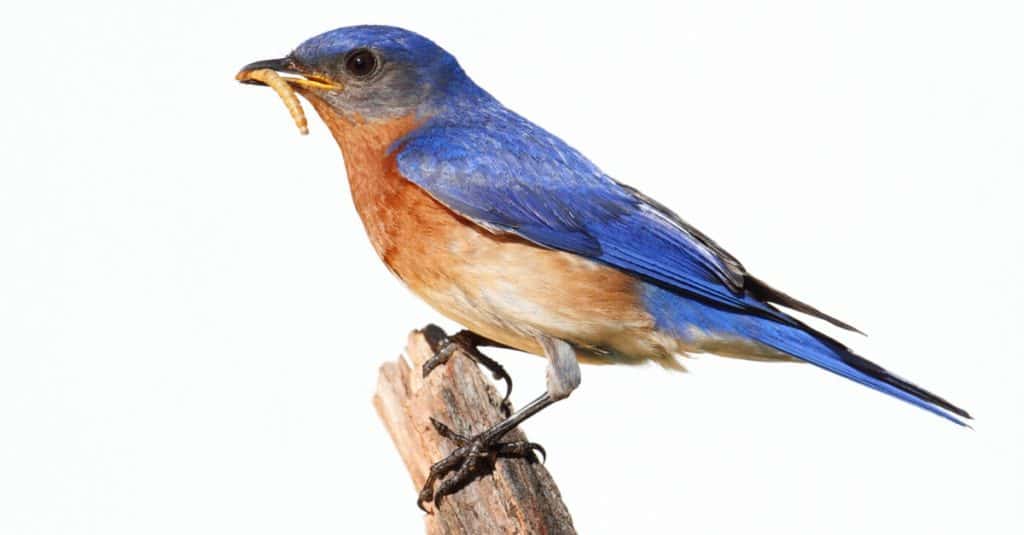
Eastern Bluebirds are mostly insectivorous although they are also partial to small invertebrates
©Steve Byland/Shutterstock.com
Ornithologists believe that about 68 percent of the bluebird’s diet is made up of insects and other small invertebrates such as snails and grubs. Many of these animals are harmful to plants, so the bluebird’s diet is beneficial to humans. During the colder months when animal protein is scarce, the bluebird will subsist on berries found in the woods. This includes the berries of honeysuckle, which are poisonous to humans. Vegetation sprayed with pesticides are detrimental to bluebirds and was one reason their numbers declined during the middle years of the 20th century.
Bluebirds get their water from ponds and streams and also drink from and bathe in birdbaths. Since they prefer running water to still water, a human might install a device to agitate the water in the birdbath.
Predators and Threats

Eastern bluebirds are at risk from kestrels and other birds of prey
©Milan Zygmunt/Shutterstock.com
The Eastern bluebird has to cope with a great many predators and threats. Chipmunks, raccoons, and flying squirrels, snakes, and cats steal eggs and nestlings. Aggressive sparrows and starlings chase them out of a territory. Fire ants sting nestlings to death then devour them. Birds of prey such as kestrels, hawks, and owls make meals of both adults and young.
Sometimes a migratory bluebird returns to its southern home too early in the season and may freeze to death or starve. Though the Eastern bluebird is long-lived for a little bird, most birds don’t live past their first year. Humans need to make sure that feeders and baths are kept clean, for birds can pass such diseases as salmonella, avian pox, and trichomoniasis among each other. Eastern bluebirds can also be plagued by parasites such as lice and blowflies.
Reproduction, Babies, and Lifespan
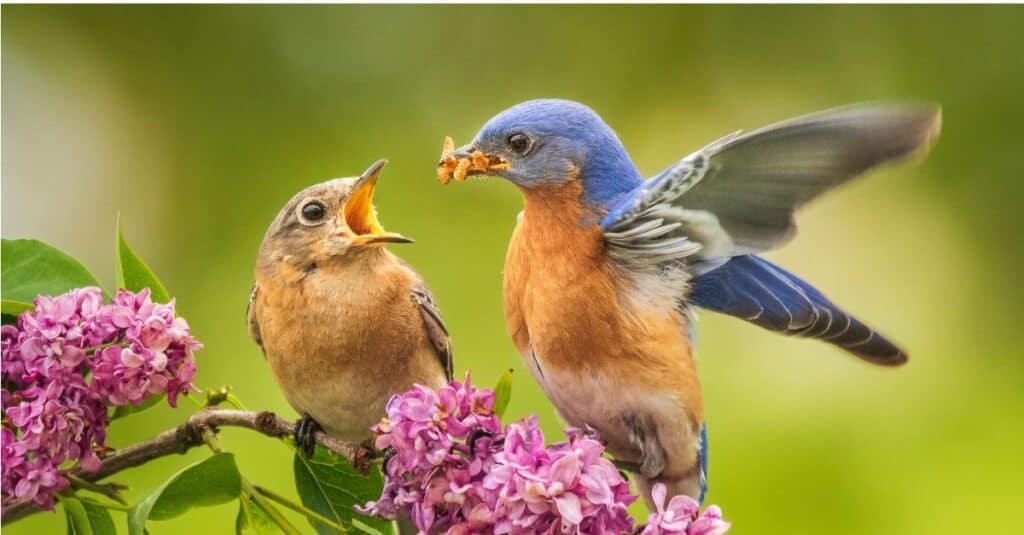
Both male and female eastern bluebirds share the responsibility of feeding their young
©iStock.com/MelodyanneM
Eastern bluebirds breed in the spring and summer and usually raise two or maybe three broods a year. The male picks a spot to build a nest and advertises it by flapping his wings and tossing a few twigs into the cavity. After mating, the female builds the nest then lays from three to seven light blue eggs. She lays one egg a day, then incubates them. They hatch in about two weeks. The chicks are helpless and fed by both parents. At first, they’re given soft-bodied food such as earthworms, but as they grow bigger and stronger the parents may bring beetles. The chicks are ready to fly the nest after 15 to 20 days and are ready to breed by next summer. The eastern bluebird’s lifespan is between six and 10 years, and the oldest known Eastern bluebird lived for 10 years and five months.
Population
Biologists believe that the Eastern bluebird population is around 20 million birds. They are not considered endangered and their numbers have recovered nicely in most areas.
View all 117 animals that start with EEastern Bluebird FAQs (Frequently Asked Questions)
Does the Eastern bluebird migrate?
Some populations migrate, while others stay in an area year-round and only migrate when food is hard to find.
How many eggs does the Eastern bluebird lay?
The Eastern bluebird lays between three to seven eggs per brood.
How fast does the Eastern bluebird fly?
It’s been clocked at 17 miles per hour.
What is the Eastern bluebird’s wingspan?
The wingspan of the bird is between 9.8 and 12.6 inches.
When do Eastern bluebirds leave the nest?
Eastern bluebird fledglings leave the nest when they’re between 15 and 20 days old.
What color are Eastern bluebird eggs?
Eastern bluebird eggs are light blue. Rarely, they are white.
What does an Eastern bluebird sound like?
Some people think the song of an Eastern bluebird sounds like, “purity purity purity,” or “truly truly truly.” The song is described as bright, bubbly, and cheerful.
What does it mean when you see an Eastern bluebird?
It means that spring is coming!
Where do Eastern bluebirds live?
Eastern bluebirds live in North and Central America, east of the Rocky Mountains.
What eats the Eastern bluebird?
Among the many things that eat Eastern bluebirds are:
- black rat snakes and black racer snakes
- eastern chipmunks
- southern flying squirrels
- sparrows
- starlings
- kestrels
- fire ants
- pet cats
- raccoons
- black bears
What are the differences between a Western bluebird and an Eastern bluebird?
The main differences between western and eastern bluebirds are that western bluebirds live in the western US and have blue chins and necks, while eastern bluebirds live in the eastern US and have orange chins and necks.
Thank you for reading! Have some feedback for us? Contact the AZ Animals editorial team.
Sources
- Wikipedia, Available here: https://en.wikipedia.org/wiki/Eastern_bluebird
- South Carolina Bluebird Society, Available here: https://southcarolinabluebirds.org/bluebird-facts-and-information/
- American Bird Conservancy, Available here: https://southcarolinabluebirds.org/bluebird-facts-and-information/
- Animal Diversity Web, Available here: https://animaldiversity.org/accounts/Sialia_sialis/
- Audubon, Available here: https://www.audubon.org/news/how-build-bluebird-nest-box
- Smithsonian, Available here: https://www.si.edu/stories/when-blue-bird-not-blue

















